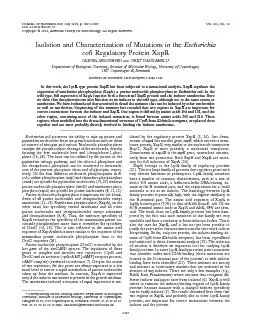

EscherichiacolipossessestheabilitytotakeuppurineandpyrimidinenucleosidesfromthegrowthmediumandusethemassourcesofnitrogenandcarbonNucleosidephosphorylasescatalyzethephosphorolyticcleavageofthenucleosi ID: 822415
Download Pdf The PPT/PDF document "OURNALOFJuly1999,p.4397±4403Vol.181,No...." is the property of its rightful owner. Permission is granted to download and print the materials on this web site for personal, non-commercial use only, and to display it on your personal computer provided you do not modify the materials and that you retain all copyright notices contained in the materials. By downloading content from our website, you accept the terms of this agreement.
OURNALOFJuly1999,p.4397±4403Vol.181,No.
OURNALOFJuly1999,p.4397±4403Vol.181,No.14Copyright1999,AmericanSocietyforMicrobiology.AllRightsReserved.IsolationandCharacterizationofMutationsintheRegulatoryProteinXapRCASPERJéRGENSENGERTDANDANELL*DepartmentofBiologicalChemistry,InstituteofMolecularBiology,UniversityofCopenhagen,1307CopenhagenK,DenmarkReceived28December1998/Accepted5May1999Inthiswork,theLysR-typeproteinXapRhasbeensubjectedtoamutationalanalysis.XapRregulatestheexpressionofxanthosinephosphorylase(XapA),apurinenucleosidephosphorylaseinEscherichiacoli.Inthewildtype,fullexpressionofXapArequiresbothafunctionalXapRproteinandtheinducerxanthosine.Hereweshowthatdeoxyinosinecanalsofunctionasaninducerinthewildtype,althoughnottothesameextentasxanthosine.Wehaveisolatedandcharacterizedindetailthemutantsthatcanbeinducedbyothernucleosidesaswellasxanthosine.SequencingofthemutantshasrevealedthattworegionsinXapRareimportantforcorrectinteractionsbetweentheinducerandXapR.Oneregionisde®nedbyaminoacids104and132,andtheotherregion,containingmostoftheisolatedmutations,isfoundbetweenaminoacids203and210.Theseregions,whenmodelledintothethree-dimensionalstructureofCysBfromKlebsiellaaerogenes,areplacedclosetogetherandaremostprobablydirectlyinvolvedinbindingtheinducerxanthosine.Escherichiacolipossessestheabilitytotakeuppurineandpyrimidinenucleosidesfromthegrowthmediumandusethemassourcesofnitrogenandcarbon.Nucleosidephosphorylasescatalyzethephosphorolyticcleavageofthenucleoside,therebyformingthefreenucleotidebaseand(deoxy)ribose-1-phos-phate(18,26).Thebasecanbeutilizedbythepurineorthepyrimidinesalvagepathway,andtheribose-1-phosphateandthedeoxyribose-1-phosphatecanbeconvertedtointermedi-atesofthepentosephosphateshuntandofglycolysis,respec-tively.Ofthefourdifferentnucleosidephosphorylasesin,uridinephosphorylase()andthymidinephosphorylase)arespeci®cforpyrimidinenucleosides(15,23)whereaspurinenucleosidephosphorylase()andxanthosinephos-phorylase()arespeci®cforpurinenucleosides(8,11,12).Purinenucleosidephosphorylaseisimportantforthebreak-downofallpurinenucleosidesanddeoxynucleosidesexceptxanthosine(11±13).Xanthosinephosphorylase(XapA),ontheotherhand,hasspeci®citytowardxanthosineandallotherpurinenucleosidesanddeoxynucleosidesexceptadenosineanddeoxyadenosine(3,8).Thus,thesubstratespeci®cityofXapAresemblesthespeci®cityofthemammalianpurinenu-cleosidephosphorylasemorethanitresemblesthespeci®cityofDeoD(10,16).Thisisalsore¯ectedintheaminoacidsequenceofXapAwhichismoresimilartothesequenceofthemammalianpurinenucleosidephosphorylasethantotheDeoDsequence(24).Purinenucleosidephosphorylase(DeoD)isencodedbythelastgeneoftheoperon.Theregulationofthesegenesiscomplexandinvolvestworepressors(CytRandDeoR)andanactivator(cyclicAMP[cAMP]receptorprotein-cAMPcomplex)(reviewedinreference7).Despitetheactionoftworepressors,thegenesarealwaysexpressedatalowbasalleveltoensurearapidmetabolismofpurinenucleosidestakenupfromthemedium.Incontrast,XapAisexpressedonlyiftheinducerxanthosineispresentinthegrowthmedium.Thexanthosine-inducedactivationofexpressionisme-diatedbytheregulatoryproteinXapR(3,24).Justdown-streamofliesanothergene,,whichencodesamem-braneprotein,XapB,verysimilartothenucleosidetransporterNupG;XapBismostprobablyanucleosidetransporter.Downstreamofisthegene,transcribedconstitu-tivelyfromtwopromoters.BothXapBandXapRareneces-saryforfullinductionofXapA(24).XapRbelongstotheLysRfamilyofregulatoryproteins(21).Thisisalargefamilyofproteinsthatregulatesgeneswithverydiversefunctionsinprokaryotes.LysRfamilymembershaveanumberofcommoncharacteristics,suchasasizeofabout300aminoacids,ahelix-turn-helixDNA-bindingdo-mainintheNterminalpart,andtherequirementforasmallmoleculetoactasaninducer.ThehomologybetweenLysRfamilyproteinsisgenerallyhigh,withthehighestsimilarityintheN-terminalpart.TheaminoacidsequenceofXapRishighlyhomologous(70%)tothatofAlsRfromE.coli.Ofthe60N-terminalaminoacidsinXapRandAlsR,68%areiden-tical.TheworkdoneonLysRfamilyproteinshasbeenham-peredbythefactthatmostmembersofthisfamilyareveryinsolubleandhaveatendencytoforminclusionbodies.ThisisalsothecaseforXapR,andithasnotyetbeenpossibletopurifytheproteinforcharacterizationandinvitroworksuchasfootprinting.Sofar,onlyoneprotein,theinducer-bindingdo-mainofCysBfromKlebsiellaaerogenes,hasbeencrystallizedandsubjectedtothree-dimensionalanalysis(25).TheisolationofmutantsisthereforeanimportanttoolforstudyingLysRfamilyproteins.InsomeLysRfamilyproteins,pointmutationsthatinterfereeitherwithDNAbinding(thesemutationsarelocatedintheN-terminalpartoftheprotein)orwithinducerbindinghavebeenidenti®ed(21).Thesemutantsaremostlynullmutantsorconstitutivemutantsthatareactivatedintheabsence
ofanyinducer.Thereareonlyafewexamples(e.
ofanyinducer.Thereareonlyafewexamples(e.g.,NahRfrom)wheremutantsthatrecognizedif-ferentinduceranalogueshavebeenisolated(4).XapRiswellsuitedtoexaminetheinducer-bindingregionsofLysRfamilyproteinsbecausemutantswithachangedinducerspeci®citycanbeeasilyisolated(3).TheresultsdescribedhereshowthattworegionsinXapR,andprobablyalsoinotherLysRfamilyproteins,areimportantforcorrectinteractionsbetweentheinducerandtheprotein.*Correspondingauthor.Mailingaddress:DepartmentofBiologicalChemistry,InstituteofMolecularBiology,UniversityofCopenhagen,Sùlvgade83H,1307CopenhagenK,Denmark.Phone:4535322025.Fax:4535322040.E-mail:dandanell@mermaid.molbio.ku.dk.MATERIALSANDMETHODSBacterialstrains.AllmutantswereisolatedinSé1053(3).Thewasintroducedinseveralsteps.First,wasP1vtransduced(17)fromME429[MC4100mdoAmalQ7malI](agiftfromW.Boos[6])intoSé430(Sé003cdd1udkadd),resultinginGD1030(Sé003cdd1udkaddmalI).Next,P1vgrownonGD1030wasusedtotransduceintoSé1053,Sé1125(Sé1053),Sé1127(Sé1053Sé1129(Sé1053),andCJM37(Sé1053),resultinginCJ115,CJ116,CJ108,CJ109,andCJ110,respectively.pGD111isalow-copy-numbermini-R1plasmidcarryingafusion,andpGD117isacontrolplasmidinwhichtheDNAisdeletedfrompGD111(24).DNAtechniques.Methodsusedfortransformation,isolationofDNAfrag-ments,andplasmidisolationsaredescribedbySambrooketal.(20).IsolationofMutationsinthegenewereisolatedbyplatingcellsofastrain(Sé1053)onplatescontainingapurinenucleosideotherthanxanthosineasthecarbonsource.Colonieswereisolatedafter4to5daysofgrowth.Theisolatedstrainsweretestedfortemperaturesensitivity(growthat32ÉCversusgrowthat42ÉC).ThisprovidedatestforthepresenceofthelambdaphageinsertedinCloningof,andalleleswereclonedbyisolationofa2,314-bpIIfragmentoftheE.colichromosomecontainingthegeneandligatedintotheRVsiteofpBR322,resultinginpCJ10,pCJ3,pCJ8,pCJ2F,andpCJ4,respectively.AftertransformationintoSé6444()(24),transformantsgrowingoninosineasthesolecarbonsourcewereselectedandthepresenceofthegenewasveri®edbyPCR(resultsnotshown).DNAsequencing.genewasampli®edbyPCRwithprimersXapR2-GTATGTCGGATATCTGGTGGTG)andXapR5(5AGTGAATCG),generatingafragmentof1,022bpcoveringtheentiregene.Mutatedgeneswereampli®edonwholeE.colicellsaddedtothePCRmixturewithatoothpick.ThePCRproductwaspuri®edwiththeQIAquickPCRpuri®cationkitpurchasedfromQiagen.Thepuri®edDNAfragmentwassequencedbycyclesequencingwithdye-labelledterminatorsandprimerXapR2,XapR5,orXapR3(5-GGTCGGGGAGAAGCAGGGCGG),usingthedyeter-minatorcycle-sequencingready-reactionkitfromPerkin-Elmer.ThesequencingreactionswererunonaPerkin-ElmerABI377orABI310DNAsequencer.Growthofcells.Cellsweregrownat32ÉCinABminimalmediumcontaining0.2%fructoseasthecarbonsourceandcomplementedwiththiamine,biotin,andCasaminoAcids(5).Purinenucleosidesweresupplementedtoaconcentrationof1mg/ml.StrainscontainingpGD111orpGD117weregrowninthepresenceof25gofampicillinperml,whilestrainscontainingplasmidderivativesofpBR322weregrowninthepresenceof100gofampicillinperml.Whencellextractswerepreparedforuseinenzymeassays,cellswere®rstgrownovernightinaminimal-mediumculturewiththeinducerpresenttoensurefullinductionof.Thenextday,theculturewasdilutedandgrownforatleastfourdoublingstoa®nalopticaldensityat436nmof0.8.Thecellswereharvestedbycentrif-ugation,washedwithABminimalmedium,andresuspendedin100mMTris-HCl±2mMEDTA(pH7.0)toacelldensityofapproximately2perml.Theharvestedcellsweresonicatedtwicefor30seach,andcelldebriswasremovedbycentrifugation.Enzymeassays.Xanthosinephosphorylaseactivitywasdeterminedat37ÉCasdescribedbyHammer-Jespersenetal.(8).-Galactosidaseactivitywasassayedat28ÉCasdescribedbyMiller(17).TheamountofproteinwasdeterminedwiththebicinchoninicacidproteinassaykitfromPiercewithbovineserumalbuminasthestandard.Theamountofenzymethatcatalyzestheconversionof1nmolofsubstrateperminde®nes1enzymeunit.IsolationofXapRmutants.SpontaneousXapRmutantswereisolatedbyplating10cellsofastrain(Sé1053)onminimalmediumcontainingapurinenucleosideotherthanxanthosineasthecarbonsource,aspreviouslydescribed(3).Coloniesappearingontheplatescanutilizethepurinenucle-osideascarbonsource.FiveofthemutantsisolatedbyBuxtonetal.(3)werestillviableandweretestedforgrowthondif-ferentnucleosidestogetherwithnewmutants(seeTable1).Originally,Buxtonetal.selectedthemutantsoninosineoradenosineasthecarbonsource.Toisolatenewclasses,weselectedformutantsthatcangrowonadenosine,deoxyade-nosine,inosine,orguanosineasthecarbonsource.Atotalof43candidateswereisolated,and18ofthesewerediscardedasrevertantsbecausetheyhadbecometemperatureresis-tantandprobablyhadlostthelambdaphageinsertedinto.Fourdifferentclasseswereidenti®edbasedongrowthpatternandwerecomparedwitharevertant(CJM25),as
showninTable1.Allfourclassesgrewequallyw
showninTable1.Allfourclassesgrewequallywellonglucoseandthenormalinducerxanthosine.Likewise,theyallgrewfairlywellonuridine,indicatingthatthegenesforpyrimidinemetabolismareintact.ClassImutantshavegainedtheabilitytogrowonallpurinenucleosidesanddeoxynucleosidestested.ClassIImutantsgrewwellonadenosine,deoxyadenosine,ino-sine,anddeoxyinosinebutdidnotgrowonguanosineorde-oxyguanosine.ClassIIImutants,ontheotherhand,grewwellonallpurinenucleosidesexceptadenosine,whereasclassIVmutantsgrewonlyonxanthosine,deoxyadenosine,anddeoxyi-nosine.Ofthe25newXapRmutants,17wereisolatedonadenosine,4wereisolatedondeoxyadenosine,and4wereisolatedoninosine.Nomutantsappearedonplatescontainingguanosineasthecarbonsource.Atotalof20mutantsbe-longedtothethreepreviouslyde®nedclasses(classesI,II,andIII).ThemostcommonclassofmutantsisclassII(11of17mutantsisolatedonadenosine).Onadenosine,mutantsap-pearedwithafrequencyof3.0,includingtherevertants.ThiscorrespondstothefrequencyobtainedbyBux-tonetal.of3.3(3).Ondeoxyadenosineandinosine,thefrequenciesofmutationweretoolowtobedeterminedaccuratelybutwerelowerthan10SequencingofXapRmutants.Ofthe30isolatedstrainsmutations,includingsomeofthemutantsiso-latedbyBuxtonetal.(3),21wereselectedforsequencingofgene.InmostcasesthegenewasPCRampli®edandsequenceddirectlyonthePCRproduct,whereasafewmutantswereclonedintopBR322andsequenced.AlltheTABLE1.GrowthpatternofmutantsderivedfromSé1053onnucleosidesanddeoxynucleosidesGrowthonGluXRARAdRIRIdRGRGdRUR**********WTIR**********************************IAR*************************IIAR****************************IIIAR**********IVAR****************ND***ND**RevThebacteriawerestreakedoutonminimalplatescontainingtheindicatedcarbonsources.(Deoxy)nucleosideswerepresentat1mg/ml,andglucosewaspresentat2mg/ml.,nogrowth;****,goodgrowthafter4to5daysofincubationat32ÉC.Abbreviations:AdR,deoxyadenosine;AR,adenosine;GdR,deoxyguanosine;Glu,gGR,guanosine;IdR,deoxyinosine;IR,inosine;UR,uridine;XR,xanthosine.WT,wildtype;Rev,revertant.ND,notdetermined.4398JéRGENSENANDDANDANELLJ.Bgenescontained1-bpsubstitutions,resultinginsingle-amino-acidreplacementsintheprotein.Theidenti-®edmutationsareshowninTable2.Atsomepositions,morethanonemutanthadthesamesubstitution.ThemutationsfallintworegionsinXapR(Fig.1).Fifteenmutationswerelo-catedinaregionbetweenaminoacids203and210.Allbut1ofthe12classIImutantswerefoundtohavemutationshere,withchangesofaminoacids203and207.Ninestrainshadsubstitutionsleadingtoalterationoftheasparticacidatposi-tion207(itwaschangedtoanasparagineinsixstrains,toaglycineinone,toatyrosineinone,andtoaglutamicacidinone);twostrainshadidenticalsubstitutionsleadingtoachangeofaprolineat203toanarginine.ThelastclassIImutantcontainedamutationatposition132,anotherregioninXapR.Apparently,mutationsatpositionsseparatedbymorethan70aminoacidsresultinsimilarphenotypes.TwoclassIVmutationswerefoundattheextremitiesoftheregionbetween203and210(Fig.1).Also,oneoftheclassImutationswasfoundinthisregionataminoacid205.ThesecondregionofmutationsinXapRisde®nedbymutationsfoundatpositions104and132.Mutationatvaline104occurredinallbutoneoftheconstitutivemutants(itwaschangedtoaglutamicacidintwostrains,toaleucineinone,andtoamethionineinone).ThetwoclassIIImutantshadamutationthatwasalsofoundinanotherclass.InSé1129,asparticacid207waschangedtoglutamicacidasinCJM28(classII),andinCJM36,valine104waschangedtoglutamicacid,asinCJM30(classI).Ineachoftheseduplicates,oneofthemutantsprobablycontainsanadditionalmutationoutsidethatinterfereswiththeex-pressionof.Thesemutationsarepresentlyunknown,buttheyarecloselylinkedto,sinceP1transductionofrestoresthewild-typephenotypes(datanotshown)andsinceallthemutantsisolatedbyBuxtonetal.transduceasasinglelocus(3).XapAinductionbyxanthosineinXapRmutants.Theactiv-ityofxanthosinephosphorylasewasdeterminedinselectedmutantsfromeachclassandcomparedtotheactivityinthewildtype(Table3).Table3showsthatexpressioninSé1053isdependentonthepresenceofxanthosineinthegrowthmedium,withaninductionratioofmorethan300-fold,thuscon®rmingpreviouslypublishedresults(3).Inthemutant(V104E),theexpressionappearstobeconstitutive,sincetheXapAlevelwashighintheabsenceaswellasthepresenceofxanthosine.Forthe®vetestedclassIImutants,adifferentinductionofXapAbyxanthosinewasseen,indicatingthatthesemutantsarenotidentical.FormostoftheclassIImutants,theinductionratiowithxanthosinewaslowerthanforthewildtype.In(E132D)and(P203R),thisisduetoaslightlyhigheruninducedlevelofXapA.In(D207Y)and(D207G),theinducedlevelwaslowerthanintheothermutantsandthewildtype,givinginductionratiosof44and150,respectively.Inthe(E132D),theinductionbyxanthosinewassimilartotheinduc-tionseeninthewil
dtype.In(D207E),aclassIIIexpressionwasco
dtype.In(D207E),aclassIIIexpressionwasconstitutive,althoughtheunin-ducedlevelwasnotashighastheinducedlevel.ThisistheoppositeofthesituationfortheclassImutant().Theinductionofbyxanthosinein(P203T)wassimilartotheinductioninthewildtype,althoughtheinducedlevelwasslightlylower.Deoxyadenosineanddeoxyinosinecanactasinducersinthewildtype.Sé1053andthemutantsweretransformedwiththelow-copy-numberplasmidpGD111,whichcarriesatransla-fusion(24).Thisallowsboththechromo-somalxanthosinephosphorylase(XapA)activityandthelactosidaseactivitytobemeasured.WhenXapAand-galactosidaseactivitieswerecomparedinculturesgrownwithorwithoutxanthosine,similarresultswereobtained(Ta-bles3and4).However,theinductionratiowashigherforthe-galactosidaseactivity(1,700-fold)thanforthechromosomalactivity(300-fold).Whenotherpurinenucleosideswereusedasurprisingresultwasobtained.Deoxyadenosineanddeoxyinosineinducedfromanuninducedlevelof20U/mgofproteinto835and1,285U/mgofprotein,respec-tively.Thisisunexpectedsinceastraincannotgrowonplateswheneitherofthesecompoundsissuppliedasthecar-bonsource(Table1).Theothertestedpurinenucleosidescouldnotfunctionasinducersofinthewildtype.InductionofafusionbypurinenucleosidesinXapRmutants.TofurthercharacterizetheisolatedXapRmutants,the-galactosidaseactivitywasmeasuredinstrainscarryingpGD111(Table4).Theactivityofthesioninmutantsfromeachclasswasalsodeterminedinthepresenceofpurinenucleosidesotherthanxanthosine(Table4).Inwasclearlyexpressedconstitu-tively,sincehighenzymelevelscouldbemeasuredonalltestedFIG.1.Inducer-bindingregionsinXapRasde®nedbytheisolatedpointmutations(shownabovethe®gure).TheregionsproposedbySchell(21)areshownasgreyboxes.AlsoshownistheproposedDNA-bindingregionattheN-terminalpartoftheprotein.TABLE2.Sé1053strainscarryingCodonchangeAminoacidARTACGACTyr205AspIARGAAGACGlu132AspIIARGACAACAsp207AsnIIIRGTGGAGVal104GluIARGACGAAAsp207GluIIIARGTGTTGVal104LeuIARGACAACAsp207AsnIIARCCCCGCPro203ArgIIARGACTACAsp207TyrIIARGTGATGVal104MetIARGACAACAsp207AsnIIARGACAACAsp207AsnIIARGACAACAsp207AsnIIARGACAACAsp207AsnIIARGACGGCAsp207GlyIIARGACGAAAsp207GluIIARGTGGAGVal104GluIARCCCCGCPro203ArgIIARCTGGAGVal104GluIIIARCCCACCPro203ThrIVAdRTTTTATPhe210TyrIVAR,adenosine;IR,inosine;AdR,deoxyadenosine;WT,wildtype..181,1999MUTATIONSINE.COLIXapRREGULATORYPROTEIN4399purinenucleosides.Thelevelsobtainedwithguanosine,aden-osine,inosine,anddeoxyadenosineinthemediumwerenearlythesameaseachotherbutwerelowerthantheuninducedlevelandthelevelobtainedwithxanthosine.For(D207N)(classII),XapAwasnotinducedbyguanosinebutwasinducedbytheotherpurinenucleosidestested,correlatingwellwiththegrowthpatternofclassIImutants.Theenzymelevelforthemutantwithguanosinewascomparabletotheuninducedlevel.Inthemutant,transcriptionofwaspartlyconstitutive.TheenzymelevelinthisclassIIImutantinthepresenceofguanosine,adenosine,orinosinewaslowerthanwithoutinducer,similartowhatcanbeseenforaclassImutant.Withdeoxyadenosine,theinductionwascom-parabletothatwithxanthosine.Onplates,adenosinewastheonlypurinenucleosideonwhichthismutantcouldnotgrow.Thisisdif®culttoexplain,sinceadenosineinducesXapAtoahigherlevelthandoesguanosine(3,940U/mgofproteinwithadenosinecomparedto2,700U/mgofproteinwithguanosine),whichisenoughtoallowgrowthonthisnucleoside.Sincethemutantcangrowondeoxyadenosine,themustbeintact.Thisindicatesthatinthisstrainanaddi-tionalmutationprobablyhasoccurredthatpreventsthegrowthofthismutantonadenosine.IntheclassIVmutant,guanosinecouldnotfunctionasaninducerforXapA,asfoundforclassII.AdenosineandinosineinducedXapAmorethan15-fold,butthiswasnotenoughtoallowgrowthonplates.Thetwodeoxynucleosides,ontheotherhand,inducedXapAtoalevelofabout10,000U/mgofprotein.Thisisnotaninductionlikethatseenforxanthosine,butitissuf®cientforgrowthonplates.XapAisthereforeinducedbythesamepurinenucleo-sidesasthewildtype.XapAinductioninE.coli,adenosineanddeoxyadenosinecaneitherbecleavedphosphorylyticallybyDeoDorbedeaminatedbyadenosinedeaminase()toforminosineordeoxyinosine.To®ndwhether(deoxy)ade-nosineistheactualinducerintheXapRmutantsorwhetherthedeaminatedproduct(deoxy)inosineistheinducer,wein-troducedanmutationintheXapRmutants.Theresultingstrainsweregrowninthepresenceofpurinenucleosides,and-galactosidaseactivityfromthefusiononpGD111wasdetermined(Table5).Table5showsthatadenosinecan-notfunctionasaninducerinclassIIorclassIVmutants.Thelevelsofinductionbyadenosinearelowerthantheuninducedlevelsinthesetwoclasses.ThelevelofinductionbyadenosinewashigherintheclassIIImutantthanintheclassIIandIVmutants.ThisisinagreementwiththepreviousresultsshowingthatclassIIImutantsarepartlyconstitutive.However,thelevelofinductionbyadenosinewas25timeslowerthantheun
inducedlevel.AnumberofXapRmutantswithana
inducedlevel.AnumberofXapRmutantswithanalteredinductionpat-ternofcomparedtothewildtypehavebeenisolatedinthepast(3).Thesemutantshavenowbeensequencedandanalyzedinfurtherdetail.Additionally,moremutantshavebeenisolatedandcharacterized.Theisolatedmutantsallcon-tainsingle-amino-acidsubstitutionsinXapR.Thealteredres-iduesfallintwodomainsandsuggestthattheseregionsaredirectlyinvolvedinbindingoftheinducerxanthosine.Oneregion,betweenresidue203and210,includes15ofthe21foundalterations.Theotherregionincludes®vesubstitutionsTABLE3.XanthosinephosphorylaseactivityinthepresenceorabsenceofxanthosineXapAactivity(U/mgofprotein)51,540308I1,1208200.8II91,450161II51,490298II121,260105II522044II4600150III801,5501451,100Thedataareaveragesoftwotofourindependentexperiments.Theinductionratioisinducedlevel(withxanthosine)/uninducedlevel(withoutxanthosine).WT,wildtype.TABLE4.-Galactosidaseactivityinmutantsgrownwithdifferentpurinenucleosides-Galactosidaseactivity(U/mgofprotein)NIXRGRARIRAdRIdRWT2034,5003226248401,280I52,90042,20019,30015,50018,90020,100NDII4529,9005412,70014,10021,700NDIII6,20034,9002,7003,9005,00031,800NDIV3039,000216405209,10011,300Thedataareaveragesofthreeto®veindependentexperiments.Abbreviations:NI,noinducer;XR,xanthosine;GR,guanosine;AR,adenosine;IR,inosine;AdR,deoxyadenosine;IdR,deoxyinosine.WT,wildtype.ND,notdetermined.4400JéRGENSENANDDANDANELLJ.Batposition104leadingtoconstitutiveexpressionofonesubstitutionatposition132(Fig.1).Theisolatedmutantshavebeendividedintofourclassesdependingontheirgrowthonvariouspurinenucleosides.Threeoftheseclasseswerede®nedpreviously,andoneisnew.Theexpressionofrepresentativesfromeachclasswithdifferentpurinenucleo-sidespresentinthegrowthmediumwasdeterminedbyusingafusion.ThishasledtoamoredetaileddescriptionoftheXapRmutants.Inthewildtype(i.e.,Sé1053),andthefusionareinducedbyxanthosinebyafactorofmorethan300-and1,700-fold,respectively(Tables3and4).Deoxyinosineisaninduceraswell,inducingthefusionbyafactorof65.AstraincontainingamutationexpressesXapAconstitutively.Withnoinducerpresent,theactivityis1.5timeshigherthaninthewildtypeinducedwithxanthosine.Withxanthosinepresent,themutationleadstoanactivitythatisreducedtoabout80%ofthatintheabsenceofinducer.Thiseffectisevenmorepronouncedwithother(deoxy)nucleosidespresentinthegrowthmedium.Typically,theyreducetheac-tivitybyafactorof3.Apossibleexplanationforthisisthatthesenucleosidescauseaweakcataboliterepressionthatchangesthemetabolicstateofthecell.ItisalsopossiblethattheinducersbindtothemutatedXapRprotein,changingthestructureoftheproteinandmakingitlessactive.XapRmutantsbelongingtoclassIIarethemostcommonmutants.Theyhaveretainedtheabilitytorespondtoinducers.Theactivityfromthefusionwithnoinducerpresentisonlyslightlyabovetheuninducedlevelforthewildtype(Table4).Thesemutantsmostprobablycontainamutationthatbroadensthespeci®cityofXapRforbinding(de-oxy)nucleosides.Thisbindingresemblesthebindingofxantho-sinetothewildtype,thuscausingactivationatthemoter.XapAactivitycanbemeasuredwithallthetestednucleosidesexceptguanosine.SinceclassIImutantsareun-abletogrowonguanosineordeoxyguanosineonplates,deoxy-guanosinewouldnotbeexpectedtofunctionasaninducereither.ExperimentswithSé1127,withanshowedthatadenosinehastobeconvertedtoinosinebeforeXapAactivitycanbedetected(Table5).Thesameprobablyappliesfordeoxyadenosine.ThismeansthatclassIImutantsarealteredinawaythatallowsthemtorespondtoinosine.Likethewildtype,theyalsoinduceexpressioninthepresenceofxanthosineanddeoxyinosine.ClassIIImutantsarepartlyconstitutivewithrespecttoexpression.OnlytwoclassIIImutantshavebeenisolated,andinbothcasesanothermutantwiththesamemutationhasbeenfoundthatbelongstoadifferentclass(compare).Buxtonetal.(3)reportedthatclassIIImutants(exempli®edbySé1129)wereverysen-sitivetothemetabolicstateofthecellandthatXapRperhapsmutatedtorecognizeanormalmetaboliteasaninducersincetheenzymelevelsvariedfromexperimenttoexperiment.The®ndingofidenticalmutationsindifferentclassesindicatesthatsomeofthesemutantscontainadditionalmutationsoutside.ThegeneisintactinSé1129,becausetheactivitywithadenosineislowered10-foldwhenanmutationisintroduced(Tables4and5).Still,thismutantclasscannotgrowonadenosine(Table1).Therefore,itislikelythattheclassIIImutantscontainadditionalmutationsthatinterferewiththegrowthonpurinenucleosides.TotestiftheclassIIImutantsandtheirclassIandclassIIanaloguescontainedanunlinkedmutation,theyweretransducedwithaP1lysategrownonanstrain,selectingforkana-mycinresistance.Sincemorethan90%became,theadditionalunknownmutation(s)issomewhereintheregion(datanotshown),inagreementwiththeP1transduc-tionexperimentsbyBuxtonetal.,whofoundthatallofth
eirmutantstransducedasasinglelocus(3).Cl
eirmutantstransducedasasinglelocus(3).ClassIVmutantsrespondtoxanthosineinthesamewayasthewildtypedoes.Withguanosine,thereisnoinductionofatall,whileinosinecausesaninductionofabout20-foldanddeoxyinosinecausesaninductionofmorethan300-fold.InclassIVmutants,isthereforeinducedbythesamecom-poundsasinthewildtype,althoughtheeffectofdeoxyinosineisstrongerinthepresenceofItispossiblethattheactivitiesseenforthedifferentmutantsareaffectedbyanalteredproteinstabilityofthemutantswithrespecttothewildtype.The®ndingthatinductionbyxantho-sineinallfourmutantclassesgivessimilaractivitiesofXapA-galactosidase(Tables3and4)indicatesthatallmutantshavesimilarlevelsofXapRprotein.Onemutant(containing)givesasevenfold-lowerxanthosinephosphorylaseac-tivitycomparedtothewildtypewheninducedbyxanthosine.WecannotexcludethepossibilitythatdifferencesinXapRproteinstabilityaccountforthisloweractivity.NoneoftheisolatedXapRmutantshavegainedtheabilitytoinduceinthepresenceofguanosine.Ontheotherhand,mutationsleadingtoinductionwithinosinepresentareverycommon.Thissuggeststhatthepresenceofanaminogroupatposition2inthenucleotidebasepreventsbindingtoXapR.Foralltheisolatedmutantsexcepttheconstitutiveones,adenosinemustbeconvertedtoinosinebeforeinductioncantakeplace.Thisindicatesthattheoxo-groupatposition6,whichisalsopresentinxanthosine,isimportantforbindingtoXapR.Theoxo-groupatposition2inxanthosineislessim-portantforbindingtoXapR,sincemutationsleadingtotherecognitionofinosinearecommon.TheabilityofclassIVmutantstogrowondeoxynucleosidessuggeststhatthehy-droxy-groupatposition2intheribosepartofthepurinenucleosidesisalsoinvolvedinbindingtotheprotein.Itispossiblethatitisnotthebindingpersebut,rather,aconfor-TABLE5.-Galactosidaseactivityinstrainsgrowninthepresenceofdifferentpurinenucleosides-Galactosidaseactivity(U/mgofprotein)NIXRIRARAdR2842,100281117I43,60033,80025,000NDII1614,2005,6005NDIII8,20028,2003,000325NDIV1635,1009408NDThedataareaveragesoftwoorthreeindependentexperiments.Abbreviations:NI,noinducer;XR,xanthosine;IR,inosine;AR,adenosine;AdR,deoxyWT,wildtype.ND,notdeterminedduetoheavygrowthinhibition..181,1999MUTATIONSINE.COLIXapRREGULATORYPROTEIN4401mationalchangecausedbytheboundnucleosidethatisnec-essaryforactivationtotakeplace.ThissuggeststhatXapRcanbindallpurinenucleosidesbutthatonlyafewofthesearecapableofactingasanactivator.Bindingstudieswithpuri®edXapRproteinwillmostprobablyclarifythis.Thethree-dimensionalstructureofaC-terminalfragmentoftheLysRfamilyproteinCysBfromK.aerogeneshasbeensolved(25).Theclosesimilaritybetweentheaminoacidse-quencesofLysRfamilyproteinsandcommonphysicalchar-acteristicssuchasinsolubilitycouldsuggestthatallLysRfam-ilyproteinshaveverysimilarstructures.InacomputeralignmentbetweenCysBandXapR,alltheidenti®edmuta-tionsatpositions104,132,and203to210correspondtopositionsinCysBthatareplacedclosetogetherinthethree-dimensionalstructure(Fig.2).Theseresiduesarealsoclosetothepredictedinducer-bindingdomaininCysB,whereasulfateionwasfound.Thattheseresiduesareinfactpartofaninducer-bindingsiteisunderscoredbythepresenceofpointmutationsinotherLysRfamilyproteins.Themostextensivelyexaminedregionisfromaminoacids196to206(21).ExamplesofmutationsinthisareaareC199SinOxyR(14),H195YandL204FinNodD(2),T201AinAlsR(19),andA201V,G203D,T204I,andH206YinNahR(9,22).Themutationsfoundatposition104inXapRcanbecomparedtomutationsfoundinAmpRfromCitrobacterfreundii(1).Astretchof®veidenticalaminoacidswiththesequenceGVVGTisfoundatposition102inXapRandatposition99inAmpR.ThemutationG102EwasisolatedasaspontaneousmutationinAmpR,resultinginaconstitutivephenotype.Site-directedmutagene-sisofthisresidueresultedinasimilarphenotype.Thesemu-tationslieinanareapredictedtobebetweenan-helixanda-strand.MostofthemutantsdescribedforotherLysR-typemutantsarenullorconstitutivemutants;however,nasputidamutantswithmutationsinNahRhavebeenisolatedthatbindvarioussalicylateanalogues(4).Fourmutationswereidenti®ed;threeofthesewerepositionedintheproposedin-ducer-bindingdomain(M116,R132andN169),whilethefourth(R248)mappedintheC-terminaldomain,whichisproposedtobeimportantformultimerization.TheisolatedE132DmutationinXapRliesinanareapre-dictedtobeinvolvedininteractionsbetweenmonomers(Fig.2).InNahR,amutationatexactlythesameposition(R132C)alsochangedtheinducerspeci®city(4).MostothermutationsisolatedinthisareainLysRfamilyproteinsareassociatedwithdifferentphenotypes,perhapsbecauseofdifferencesininter-actionsbetweenmonomers.WethankKoenH.G.VerschuerenforthecoordinatesofthedimericformofCysB,WinfriedBoosforthestrain,andKajFrankJensenforreadingandcommentingonthemanuscript.Bartowsky,E.,andS.Normark.1991.Puri®cationandmutantanalysisofCitroba
cterfreundiiAmpR,theregulatorforchromoso
cterfreundiiAmpR,theregulatorforchromosomalAmpCbeta-lactamase.Mol.Microbiol.Burn,J.E.,W.D.Hamilton,J.C.Wootton,andA.W.B.Johnston.Singleandmultiplemutationsaffectingpropertiesoftheregulatorygene.Mol.Microbiol.Buxton,R.S.,K.H.Hammer-Jespersen,andP.Valentin-Hansen.1980.AsecondpurinenucleosidephosphorylaseinEscherichiacoliK-12.I.Xantho-sinephosphorylaseregulatorymutantsisolatedassecondary-siterevertantsofamutant.Mol.Gen.Genet.Cebolla,A.,C.Sousa,andV.deLorenzo.1997.Effectorspeci®citymutantsofthetranscriptionalactivatorNahRofnaphthalenedegradingde®neproteinsitesinvolvedinbindingofaromaticinducers.J.Biol.Clark,D.J.,andO.Maalùe.1967.DNAreplicationandthedivisioncycleofEscherichiacoli.J.Mol.Biol.Ehrmann,M.,andW.Boos.1987.Identi®cationofendogenousinducersofreguloninEscherichiacoli.J.Bacteriol.Hammer-Jespersen,K.1983.Nucleosidecatabolism,p.203±258.Munch-Petersen(ed.),Metabolismofnucleotides,nucleosidesandnucleo-FIG.2.StructureoftheC-terminalfragmentofCysBfromK.aerogenes(25)modelledwithXapRmutations.ThepositionsinCysB(aminoacids99,128,199,201,203,and206[highlighted])thatcorrespondtothemutationsinXapRwerefoundbyClustalWsequencealignmentofthetwoaminoacidsequences(accessionno.P45600[CysB]andP23841[XapR]).Thesulfateionsbelievedtobepositionedintheinducer-bindingdomainareshown.(A)DimericformofCysB(88±324).(B)Themoleculeisturned90ÉrelativetothatinpanelA,andonlytheleftsubunitisshown.4402JéRGENSENANDDANDANELLJ.Bbasesinmicroorganisms.AcademicPress,Ltd.,London,UnitedKingdom.Hammer-Jespersen,K.,R.S.Buxton,andT.D.H.Hansen.1980.AsecondpurinenucleosidephosphorylaseinEscherichiacoliK-12.II.Propertiesofxanthosinephosphorylaseanditsinductionbyxanthosine.Mol.Gen.Genet.Huang,J.Z.,andM.A.Schell.1991.InvivointeractionsoftheNahRtranscriptionalactivatorwithitstargetsequences.Inducer-mediatedchangesresultingintranscriptionactivation.J.Biol.Chem.Ikezawa,Z.,T.Nishino,K.Murakami,andK.Tsushima.1978.Purinenucleosidephosphorylasefrombovineliver.Comp.Biochem.Physiol.Ser.BJensen,K.F.1976.PurinenucleosidephosphorylasefromSalmonellatyphi-Escherichiacoli.Initialvelocitykinetics,ligandbinding,andreactionmechanism.Eur.J.Biochem.Jensen,K.F.,andP.Nygaard.1975.PurinenucleosidephosphorylasefromEscherichiacoliSalmonellatyphimurium.Puri®cationandsomeproper-ties.Eur.J.Biochem.Kocharyan,S.M.,andY.V.Smirnov.EscherichiacoliK-12mutantscapableofcatabolizingpurinenucleosideswithouttheparticipationofpu-rinenucleosidephosphorylase.Sov.Genet.Kullik,I.,M.B.Tolodano,L.A.Targalia,andG.Storz.1995.Mutationalanalysisoftheredox-sensitivetranscriptionalregulatorOxyR:regionsim-portantforoxidationandtranscriptionalactivation.J.Bacteriol.Leer,J.C.,K.Hammer-Jespersen,andM.Schwartz.1977.Uridinephos-phorylasefromEscherichiacoli:physicalandchemicalcharacterization.Eur.J.Biochem.Lewis,A.S.,andB.A.Lowy.1979.Humanerythrocytepurinenucleosidephosphorylase:molecularweightandphysicalproperties.ATheorell-Chancecatalyticmechanism.J.Biol.Chem.Miller,J.H.1972.Experimentsinmoleculargenetics.ColdSpringHarborLaboratory,ColdSpringHarbor,N.Y.Neuhard,J.,andR.A.Kelln.1996.Biosynthesisandconversionsofpyrimi-dines,p.580±599.F.C.Neidhardt,R.CurtissIII,J.L.Ingraham,E.C.C.Lin,K.B.Low,B.Magasanik,W.S.Reznikoff,M.Riley,M.Schaechter,andH.E.Umbarger(ed.),Escherichiacoli:cellularandmolec-ularbiology,2nded.AmericanSocietyforMicrobiology,Washington,D.C.Renna,M.C.,N.Najimudin,L.R.Winik,andS.A.Zahler.1993.RegulationoftheBacillussubtilisalsS,andgenesinvolvedinpost-exponential-phaseproductionofacetoin.J.Bacteriol.Sambrook,J.,E.F.Fritsch,andT.Maniatis.1989.Molecularcloning:alaboratorymanual.ColdSpringHarborLaboratory,ColdSpringHarbor,Schell,M.A.1993.MolecularbiologyoftheLysRfamilyoftranscriptionalregulators.Annu.Rev.Microbiol.Schell,M.A.,P.H.Brown,andS.Raju.1990.UseofsaturationmutagenesistolocalizeprobablefunctionaldomainsintheNahRprotein,aLysR-typetranscriptionalactivator.J.Biol.Chem.Schwartz,M.1978.ThymidinephosphorylasefromEscherichiacoli.Meth-odsEnzymol.Seeger,C.,C.Poulsen,andG.Dandanell.1995.Identi®cationandcharac-terizationofgenes(,and)involvedinxanthosinecatabolismEscherichiacoli.J.Bacteriol.Tyrrell,R.,K.H.G.Verschueren,E.J.Dodson,G.N.Murshudov,C.Addy,andA.J.Wilkinson.1997.Thestructureofthecofactor-bindingfragmentoftheLysRfamilymember,CysB:afamiliarfoldwithasurprisingsubunitarrangement.StructureZalkin,H.,andP.Nygaard.1996.Biosynthesisofpurinenucleotides,p.F.C.Neidhardt,R.CurtissIII,J.L.Ingraham,E.C.C.Lin,K.B.Low,B.Magasanik,W.S.Reznikoff,M.Riley,M.Schaechter,andH.E.Umbarger(ed.),Escherichiacoli:cellularandmolecularbiology,2nded.AmericanSocietyforMicrobiology,Washington,D.C..181,1999MUTATIONSINE.COLIXapRREGULATORYPROTEIN44